





DELAMINAZIONI E TENTATIVO DI RIMEDIO
Come molti sapranno , uno dei problemi più gravi che affliggono i sistemi ottici del nostro microscopio, sono le delaminazioni.
Queste altro non sono che scollamenti che avvengono tra due superfici ottiche che siano lenti prismi etc.
Difficile dire quale sia la causa ; forse un collante che nel corso degli anni si deperisce oppure il diverso coefficiente termico tra le ottiche stesse e le montature metalliche che le ospitano, ottone primo tra tutti; fatto stà che questa specie di “cancro” dell’ottica c’è e lentamente avanza portando ,prima o poi , ad un totale inutilizzo dell’ottica o prisma che sia.
Personalmente trovo fastidioso sapere e vedere che un elemento ottico (in particolar modo se mi appartiene) sta andando incontro alla fine senza almeno provare a rimediare; ed è quello che stava succedendo ad un mio prisma DIC (numero I) del terzo sistema interferenziale Zeiss 160mm.
Quello che ho fatto è appunto cercare di ragionarci un attimo su e tentare qualcosa; premetto che ero ben consapevole che avrei potuto rimetterci il prisma in caso di manovre azzardate ma ho voluto rischiare comunque…
Il condensatore che ospita anche il prisma in questione è stato acquistato nell’Aprile 2008 dal Nord America; nel momento in cui l’ho ricevuto aveva una delaminazione con uno spessore circa 2-2,5mm (come si vede dalla foto in basso). Ho notato che ogni anno con l’arrivo della stagione calda (Maggio – Ottobre) la delaminazione avanzava di un certo ammontare per poi rimanere stabile nella stagione fredda e ricominciare ad avanzare l’anno seguente;
nella foto è possibile vedere le bande di accrescimento che si sono formate in questi anni che lo possiedo ed è facile notare che :
il condensatore ha almeno 20 anni e anche di più e che fino al 2008 si è delaminato un poco, ma in 3 anni con la nostra escursione termica si è delaminato anche di più in un tempo minore…quindi alla luce di tutto ciò mi viene da pensare che la colpa non è solo del collante ma ci devono essere altre cause come ad esempio il diverso coefficiente di dilatazione termica esistente tra la struttura in ottone che regge il prisma e il prisma stesso. Ovviamente questa è una mia ipotesi soltanto!
DELAMINATIONS AND ATTEMPT TO REPAIR
As many microscopists will know, one of the most serious problems of our optical microscope , are delaminations.
These are decementings that occur between two opticals surfaces lenses , prisms etc..
Hard to say what is the cause, perhaps a glue that deteriorates over the years or the different thermal coefficient between the optical and metal mounting, brass first of all.
The fact is that this sort of ‘cancer’ of optics is advancing and slowly ,sooner or later, it’ll make optics unusable.
personally I’ve trouble when I see that an optical element (especially if it one of mine) is going to the end without at least trying to remedy, and that’s what was happening to my prism DIC (number marked “I”) of the third system, 160mm Zeiss interferential .
What I did is just tryed to reason for an instant.
I was aware that I could lose the prism in the case of risky proceedings, but I still want to risk …
The condenser, which also houses the prism in question was purchased in April 2008 from North America, when I received it had a delamination with a thickness of about 2-2,5 mm (as shown in the photo below) . I noticed that every year, with the arrival of the warm season (May to October) the delamination advance of a certain amount and then remain stable in the cold season and start moving forward again the following year;
in the photo you can see the growth bands that were formed during these years and it is easy to understand that:
the condensator has at least 20 years and more, and that until 2008 was delaminated a little, but in 3 years with our temperature range, delamination is grown even more in less time … than I think that the problem is not only the adhesive but there must be other causes such as the different coefficient of thermal expansion between the brass structure that holds the prism and the prism itself. Obviously it is only my idea!
TENTATIVO DI RIMEDIO
La prima cosa che ho fatto, dopo aver tolto il prisma dalla sua sede nel condensatore, è stata quella di analizzarlo visivamente sotto lo stereoscopio.
Il prisma mostrava tutte le zone di contatto sigillate (vedi foto in basso); precisamente:
le zone non arrotondate dove vi era uno spazio più ampio erano sigillate con del silicone, mentre le zone arrotondate che seguivano il profilo del porta prisma in ottone, erano sigillate con una specie di cemento non tanto duro a dire il vero.
Visto che la delaminazione è uno scollamento, ho pensato che il “vuoto” lasciato dal collante poteva essere riempito in qualche modo; anche perché la delaminazione arrivava alla periferia del prisma, quindi proprio da qui si poteva partire; ora che ci penso bene non ricordo di avere mai visto delaminazioni partire dal centro.
Con un ago ho provveduto ad asportare il silicone e il cemento in corrispondenza della scollatura ead eliminare accuratamente i piccoli residui con un ago ancora più fino (vedi foto). Con lo stesso ago ho iniziato a passarlo sul punto di contatto dei due prismi di Wollaston (dal lato dove era il silicone in corrispondenza della delaminazione).
Fatto ciò ho inserito una piccola goccia di olio da immersione nella stessa apertura ed ho atteso due minuti senza che accadesse nulla.
Ero ormai deciso a rassegnarmi e a rimontare il prisma quando ho notato una piccolissima macchia scura sulla delaminazione che prima non c’era…allo stereoscopio essa mostrava dei sottili filamenti che partivano dalla periferia; non avevo dubbi , qualcosa stava accadendo. Con un phon ho iniziato a soffiare aria calda un poco alla volta; la cosa non cambiava molto perché la goccia di olio che avevo versato in precedenza era ormai colata via ; ormai incoraggiato ho voluto provare il tutto per tutto: ho immerso il prisma in un contenitore con 1 mm di olio da immersione.
20 minuti dopo la delaminazione si era ridotta del 40%; dopo 1 ora vi era un residuo che si è ridotto ancora quando, sistemato il prisma su una piccola morsa, gli ho soffiato aria calda (attenzione: soffiare poco alla volta altrimenti il calore eccessivo potrebbe lesionare il prisma). 3 ore dopo era rimasto circa il 5% . come è possibile vedere dalle foto
Tutto questo procedimento è stato effettuato circa 2 mesi fa; oggi che scrivo l’articolo con l’Estate ormai iniziata vi comunico che anche quel residuo è sparito..adesso il prisma sembra nuovo e spero lo rimanga almeno per un bel po’.
Farò ovviamente dei controlli in autunno e se le cose non cambiano cercherò di sistemarmi anche qualche altro prisma.
Incrociamo le dita allora!!
Cordialmente
Arturo Agostino
ATTEMPT TO REPAIR
The first thing I did, after removing the prism from its hole in the condenser, was to inspect it under the stereoscope.
The prism showed all the contact areas sealed (see photo below):
Not rounded areas where there was a larger space was sealed with silicon, while the rounded areas that followed the profile of the prism, (brass holder), were sealed with a kind of cement i not so hard .
Since delamination is a detachment, I thought that the “empty zone” could be filled in some way, because the delamination reached the border of the prism; then I started from here, and now that I think well I do not remember have never seen delaminating from the center.
I used a needle to remove the silicon and cement (see photo). With the same needle I started to pass it on the point of contact of the two Wollaston prisms (from the side where was the delamination).
Without silicon, I added a small drop of immersion oil in the same opening and waited two minutes……. nothing happened.
I was now determined to resign and replace the prism when I noticed a small dark spot on the delamination was not there before … it showed the stereoscope of thin filaments that started from the periphery, I had no doubt, something was happening. I began with a hair dryer to blow hot air a little at a time, it did not change much ;
encouraged now I wanted to try all out: I dipped the prism in a container with 1 mm of immersion oil.
20 minutes after, the delamination was reduced by 40%;
after 1 hour there was a residue that was reduced even when the prism placed on a small vise, I have blown hot air (note: just blow a little or the excessive heat could damage the prism).
3 hours later it was still around 5%. As you can see from the photos
All this procedure was performed about 2 months ago.
today that I am writing this article in the summer I’m happy to inform you that residue is gone out now .. the prism looks new and I hope it remains for a long time!
of course i’ll control it in the October -November and if it do not change I will try to “repair” some of the other prism.
Fingers crossed then!
Cordially
Arturo Agostino
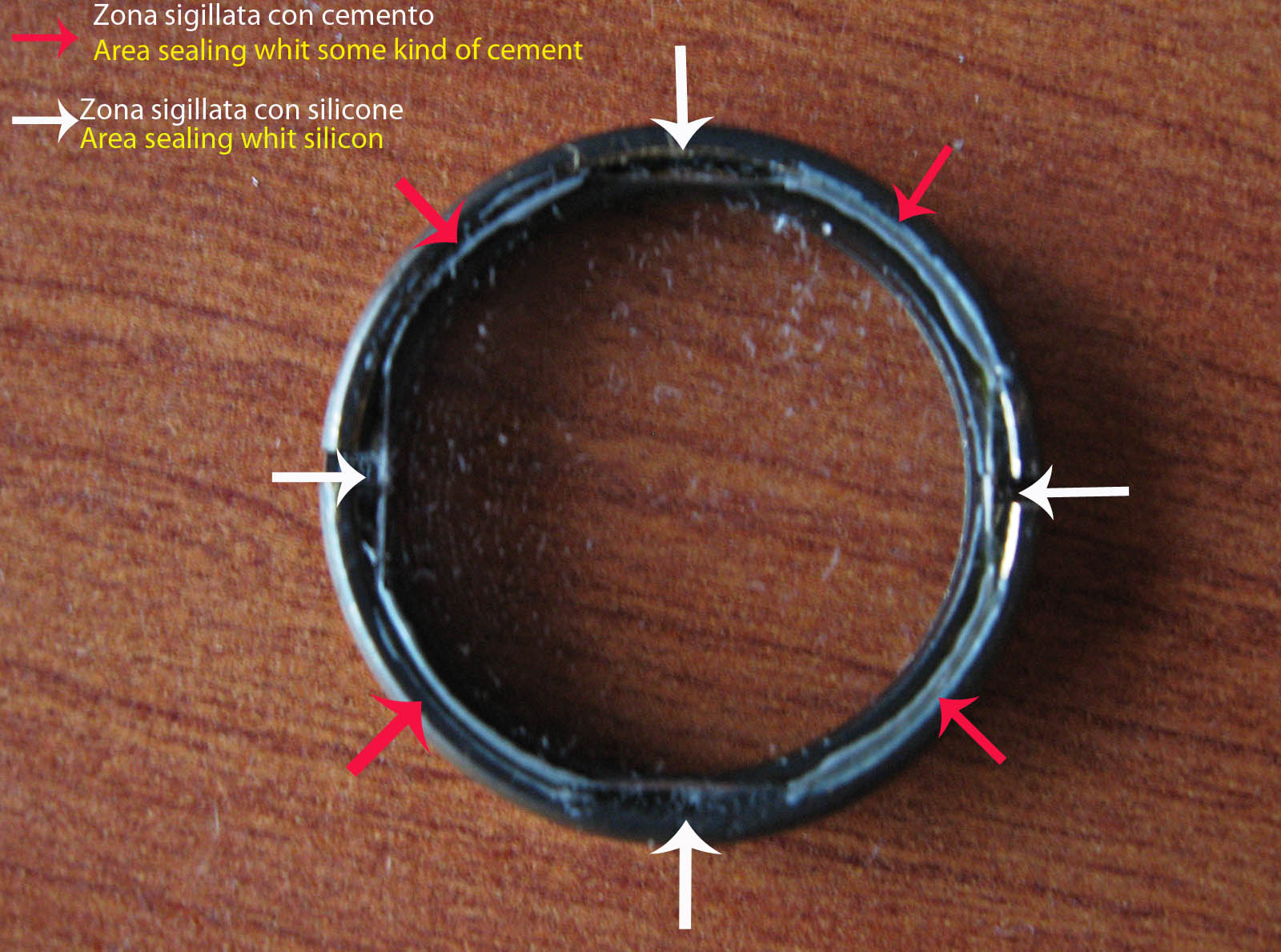
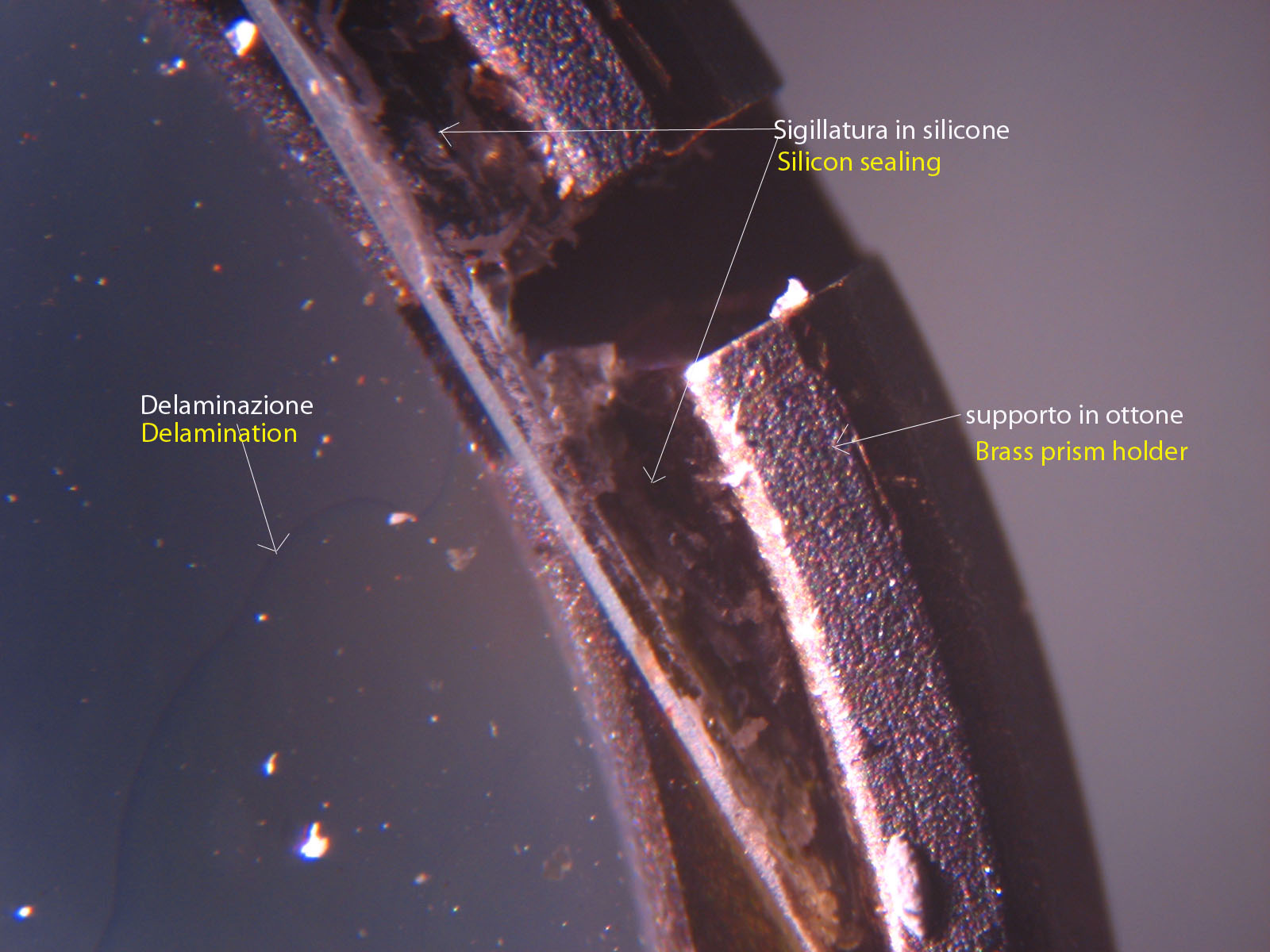
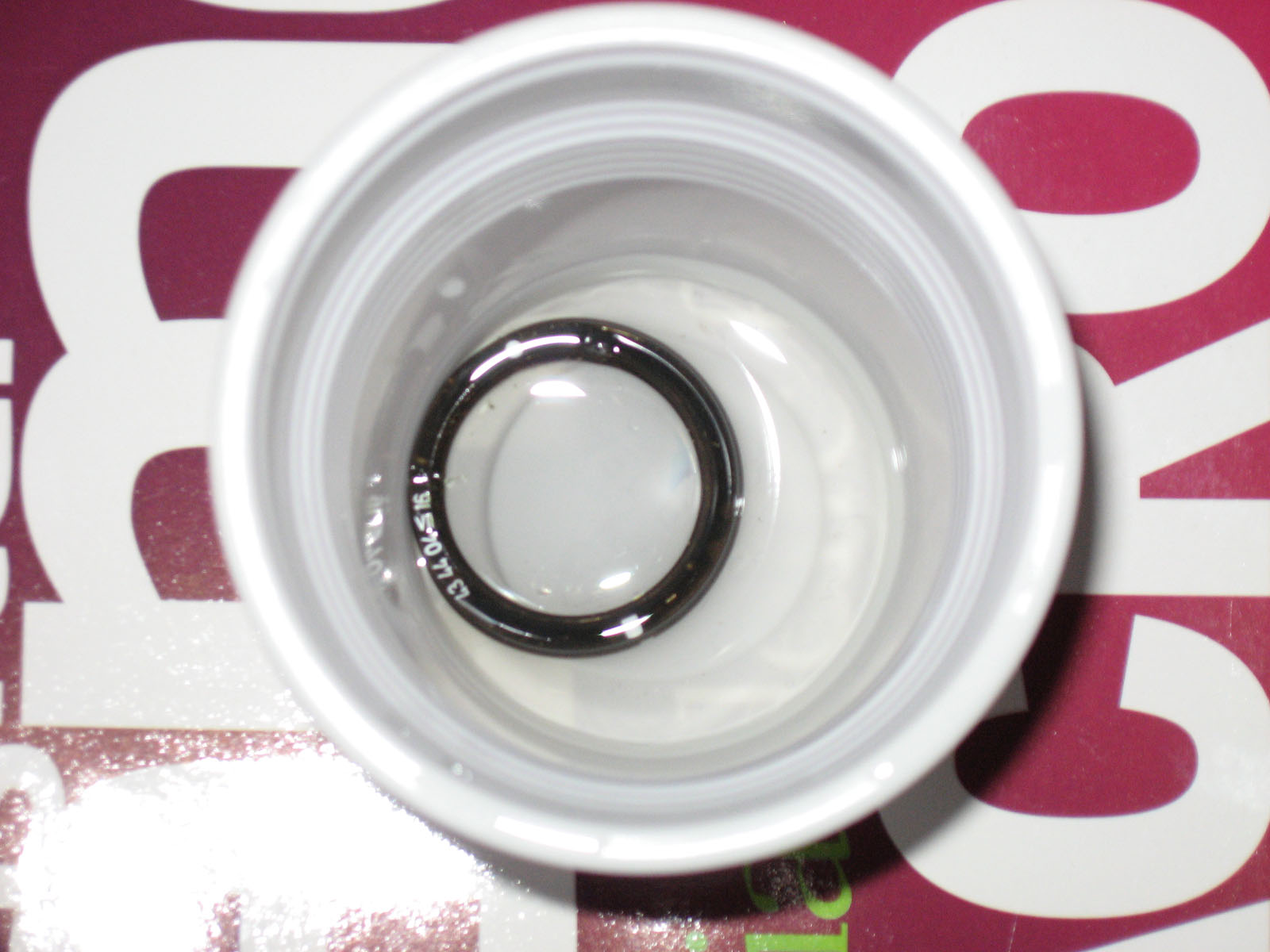
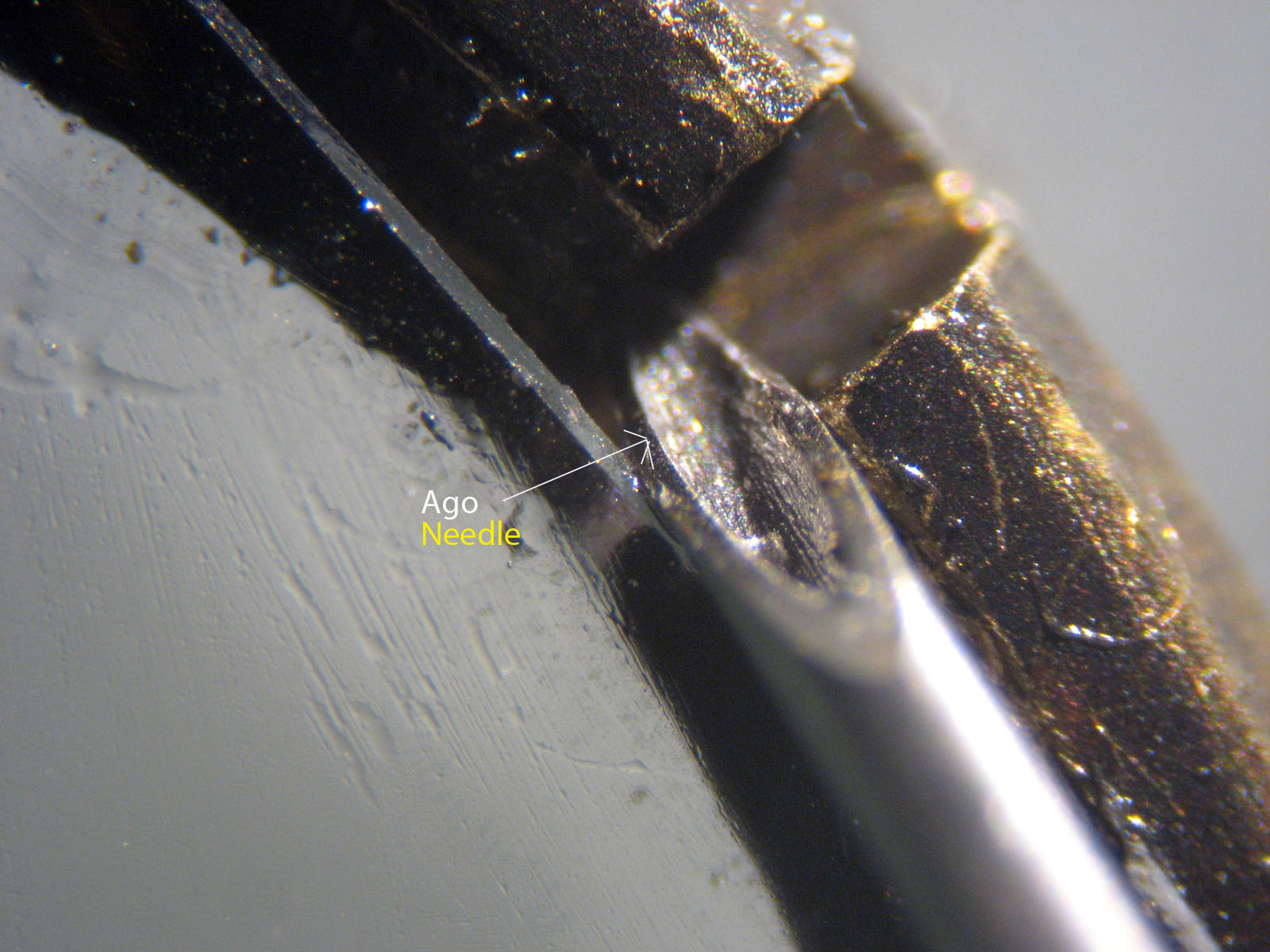
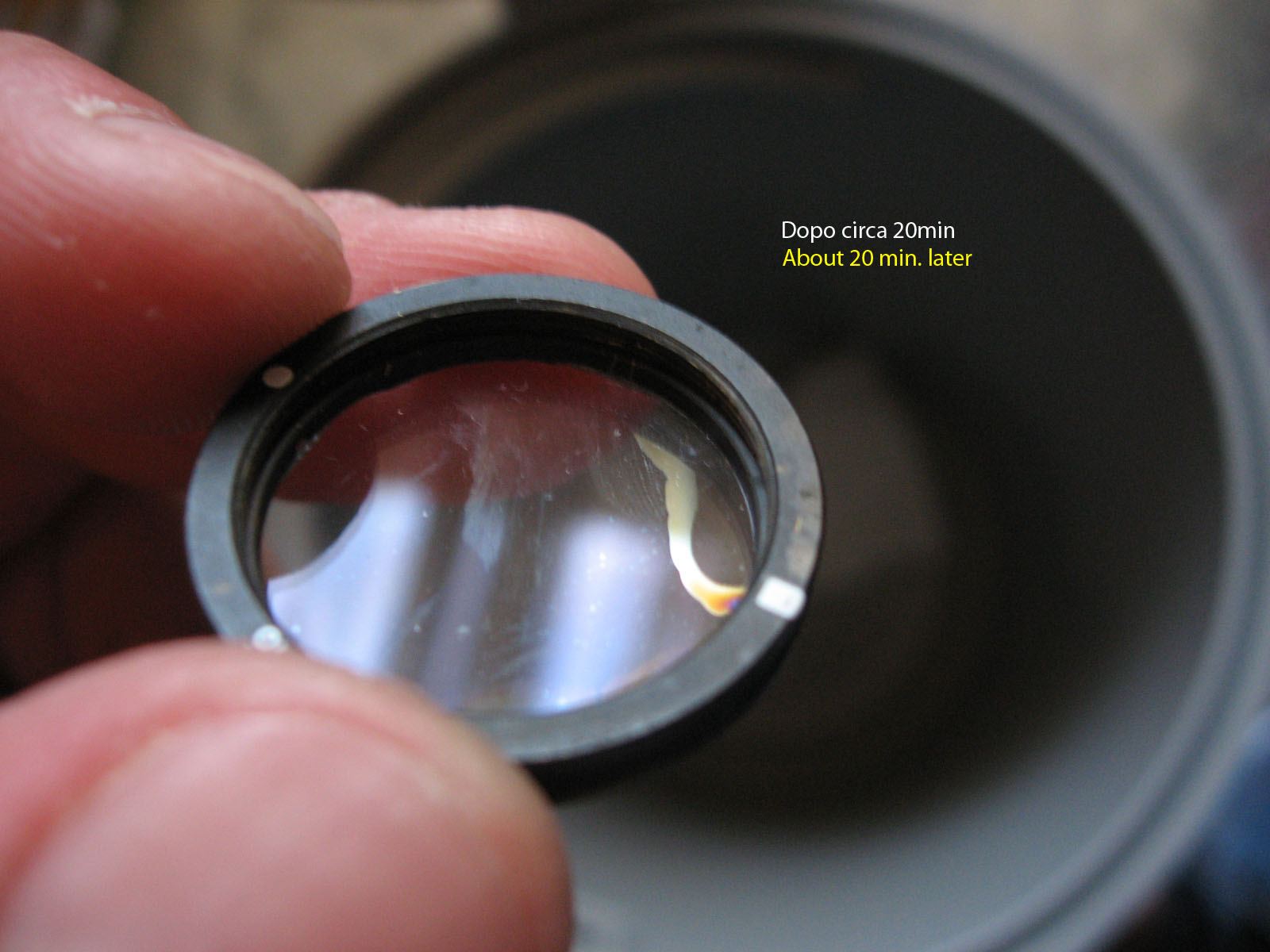
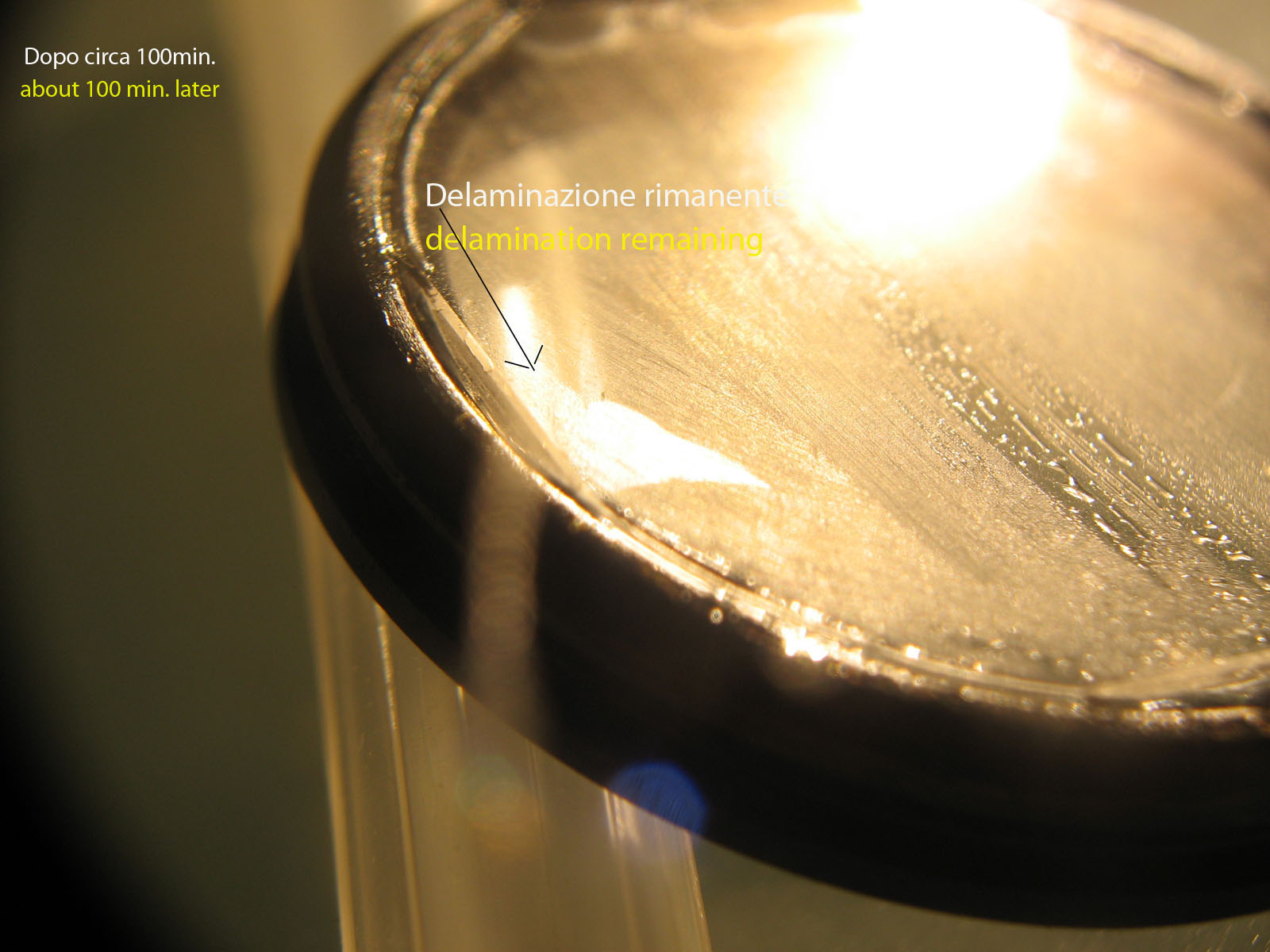
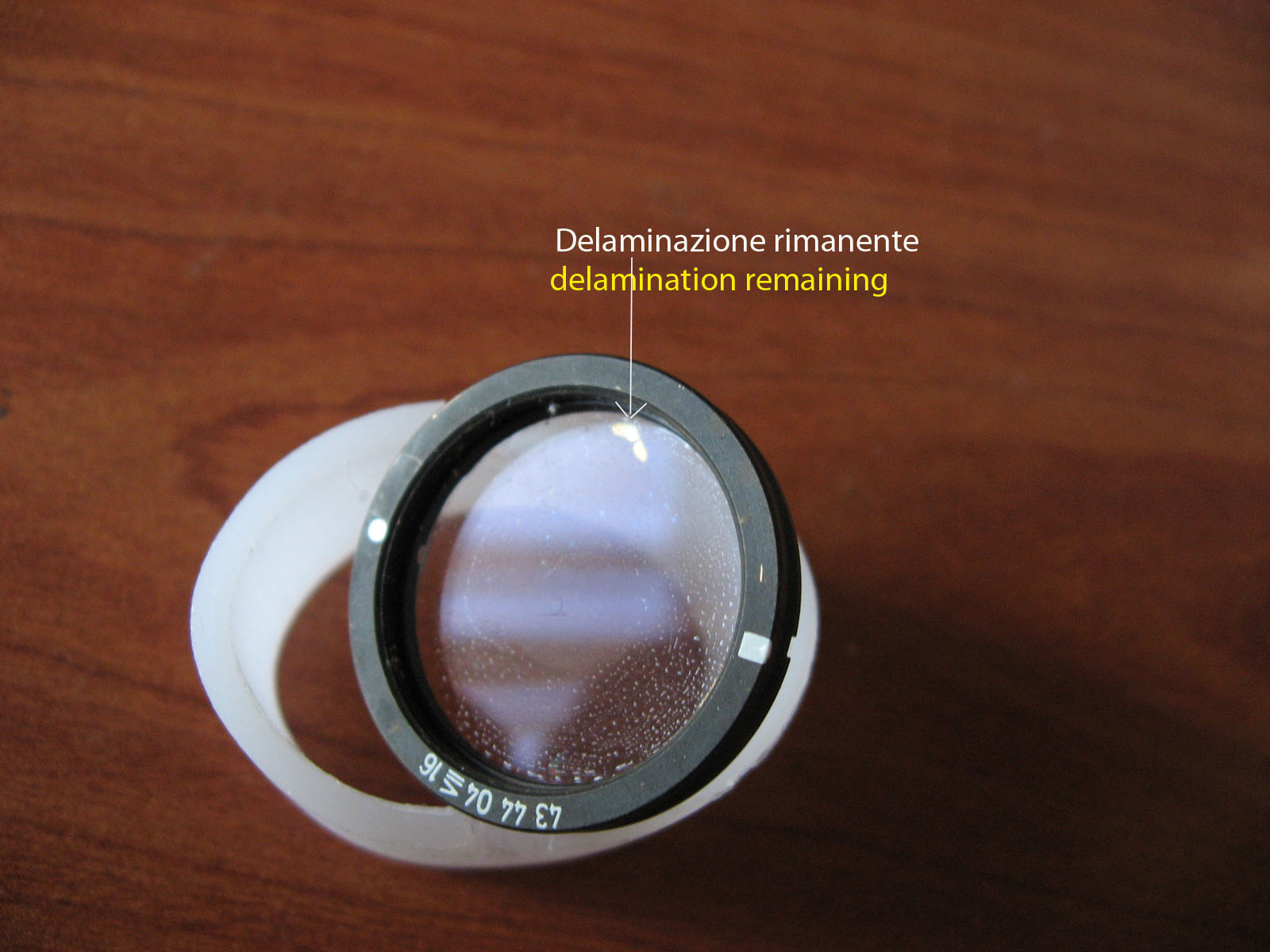

L’ultima immagine mostra il prisma oggi senza segni apparenti di delaminazione!
Last pic show the prism today whit no sign of delaminations!
ECCO COSA NE PENSA UN ESPERTO
il Dott. Pietro Sini
(risposta alla lettera di Andrea Pierattini)
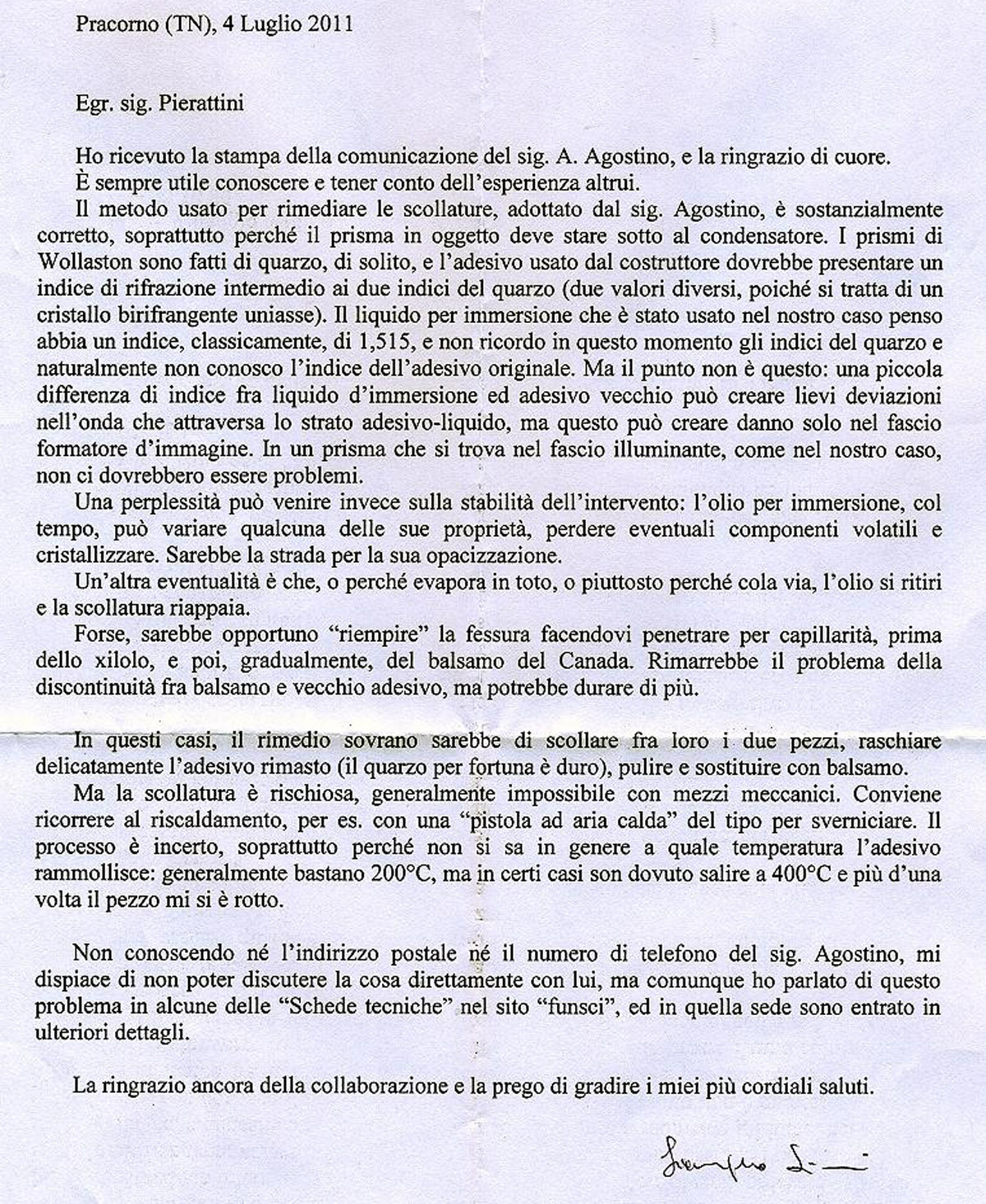
In basso vengono riportate alcune esperienze da parte di microscopisti che hanno avuto benefici seguendo questo metodo!
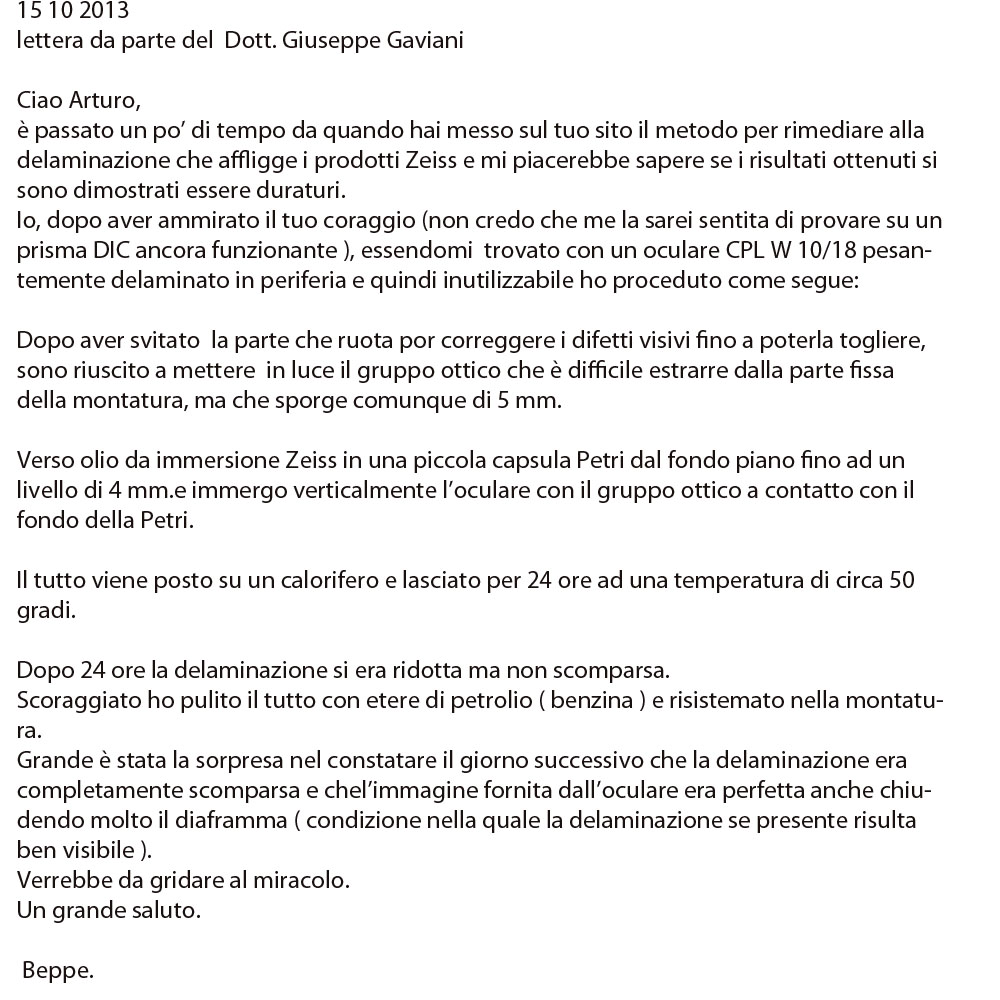
Note:
Le parti ottiche sono estremamente delicate e soggette a rotture o lesioni in genere se non vengono adottate le dovute cautele; per cui declino ogni responsabilità per danni eventuali dovute ad interventi maldestri e privi di una conoscenza di base!
Optics part are very delicate and subject to chipping or other damage; so i decline any responsability for damage caused by clumsy actions and lack of basic knowledge!
Aggiornato al
Updated to
21/11/2011
Il prisma si presenta perfettamente trasparente senza la minima traccia di delaminazione!
Prism is perfectly clean of any trace of delamination!
27/06/2012
A distanza di più di un anno non vi è traccia della delaminazione.
Over one year of time, there is NO traces of delamination.
11/07/2013
Dopo due anni nessun segno di delaminazione
After two years no signs of delaminations
At present 10/12/2016
Nessuna delaminazione sul prisma
Absolutely no sign of delaminations
19 03 2020
Prisma perfetto prism perfect